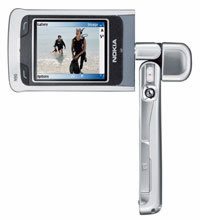 More and more people are using computers or portable players for music, even though traditional radio still leads the competition, according to a recent market study.
More and more people are using computers or portable players for music, even though traditional radio still leads the competition, according to a recent market study.
The report from market researcher, The NPD Group, revealed that approximately 77.2 million customers grooved to music stored on a computer during March 2005 – up 22 percent from the 63.2 million recorded during the same month last year.
Online radio stations also enjoyed an upturn in popularity, with 53.5 million listeners tuning in this March, up from 45.3 million a year ago.
Free streaming of music also saw notable gains, with a rise of 37 percent, to 46 million listeners.
Traditional radio continues to be the preferred medium, but listening audiences shrank 4 per cent to 194 million, down from 203 million a year earlier.
“The rise of digital listening and storage for music continues unabated this year,” Russ Crupnick, president of the Music and Movies division at NPD, said in a statement. “Technology companies are providing new tools to consumers in the form of powerful music-enabled PCs and portable music players; music companies are answering the call for more content; and consumers are responding positively.”
There’s a right royal barney going on in the online music business, with several big names fighting it out for a fat slice of the lucrative download market, currently dominated by Apple’s iTunes store and iPod music players.
 Last week, Yahoo revealed their determination to become big noise in the music industry, unveiling a music subscription service that significantly undercuts their rivals.
Last week, Yahoo revealed their determination to become big noise in the music industry, unveiling a music subscription service that significantly undercuts their rivals.
According to the NPD survey, the number of consumers ripping music onto their computers has more than doubled since March 2004, with a substantial (127 percent) increase in music transferred to MP3 players since last year.
With a 93 percent increase in paid music downloads during the same period registered, online music is becoming increasingly accepted.
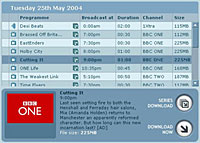 BBC New Media is to extend trials of its interactive Media Player (iMP), allowing viewers to download material from 500 hours of its television and radio programming.
BBC New Media is to extend trials of its interactive Media Player (iMP), allowing viewers to download material from 500 hours of its television and radio programming. The 5,000 trialists will be able to search for programmes they want to watch, filter programmes by channel, select subtitles and, in the case of some series, to collect and watch episodes that they may otherwise have missed.
The 5,000 trialists will be able to search for programmes they want to watch, filter programmes by channel, select subtitles and, in the case of some series, to collect and watch episodes that they may otherwise have missed.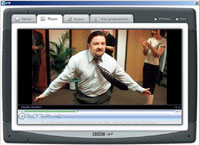 The pilot will use DRM software to delete programmes seven days after the programme has aired on TV, ensuring that users can no longer watch the content after that time. The digital rights system will also prevent users emailing the files to their chums or sharing it via disc.
The pilot will use DRM software to delete programmes seven days after the programme has aired on TV, ensuring that users can no longer watch the content after that time. The digital rights system will also prevent users emailing the files to their chums or sharing it via disc.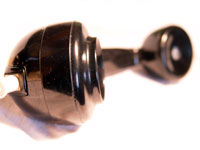 AOL today trumpeted its intention to muscle into the UK phone business with the launch of a home service offering unlimited calls for an introductory flat rate of £7.99 (~US$14, ~€11) per month.
AOL today trumpeted its intention to muscle into the UK phone business with the launch of a home service offering unlimited calls for an introductory flat rate of £7.99 (~US$14, ~€11) per month. Johnny-come-lately subscribers signing up after 30 June 2005 will pay this standard monthly subscription fee.
Johnny-come-lately subscribers signing up after 30 June 2005 will pay this standard monthly subscription fee.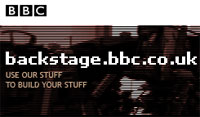 The BBC has let rip with a new beta service that invites Web developers and designers outside of the organisation to start fiddling about with their content and “create cool new things”.
The BBC has let rip with a new beta service that invites Web developers and designers outside of the organisation to start fiddling about with their content and “create cool new things”. The UK broadcasting goliath made a commitment to support social innovation in response to last year’s Graf Report, and this is echoed in their plans to develop an open community where people can share expertise, ideas, and collaborative efforts.
The UK broadcasting goliath made a commitment to support social innovation in response to last year’s Graf Report, and this is echoed in their plans to develop an open community where people can share expertise, ideas, and collaborative efforts. It’s not all about profit though, with the BBC hoping that contributors will create prototypes on their Web sites to be freely shared with others for non-commercial use.
It’s not all about profit though, with the BBC hoping that contributors will create prototypes on their Web sites to be freely shared with others for non-commercial use. Telewest Broadband today announced plans to transform its TV service, giving consumers greater access and control over additional digital programmes.
Telewest Broadband today announced plans to transform its TV service, giving consumers greater access and control over additional digital programmes. There will also be a mix of free and subscription services including popular TV series, music videos and niche content.
There will also be a mix of free and subscription services including popular TV series, music videos and niche content. Eric Tveter, president and chief operating officer at Telewest sunk deeper into his deluxe executive chair and glossed: “We are transforming TV as we know it by giving consumers both a superb choice of programmes and the flexibility to watch them whenever they want. We don’t ever want to hear our customers say there’s nothing on the box or that they have missed their favourite programme.”
Eric Tveter, president and chief operating officer at Telewest sunk deeper into his deluxe executive chair and glossed: “We are transforming TV as we know it by giving consumers both a superb choice of programmes and the flexibility to watch them whenever they want. We don’t ever want to hear our customers say there’s nothing on the box or that they have missed their favourite programme.”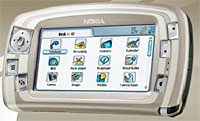 NTL Broadcast and O2 have revealed the first batch of channels to be part of their forthcoming mobile TV trial in the Oxford area, announcing an initial 16 channels including Cartoon Network, CNN, Discovery Channel, Sky Sports News and Sky Travel.
NTL Broadcast and O2 have revealed the first batch of channels to be part of their forthcoming mobile TV trial in the Oxford area, announcing an initial 16 channels including Cartoon Network, CNN, Discovery Channel, Sky Sports News and Sky Travel.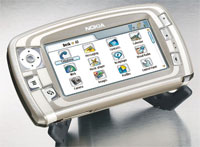 To support the trial, NTL Broadcast is building a new broadcast network of eight DVB-H transmitters to cover 120 square km around Oxford that will enable the lucky participants to receive digital television on the move. To enable a commercial service to be launched in the UK, Ofcom will need to license spectrum and O2 is already lobbying the UK regulator to bring forward plans to distribute radio frequencies for mobile TV services.
To support the trial, NTL Broadcast is building a new broadcast network of eight DVB-H transmitters to cover 120 square km around Oxford that will enable the lucky participants to receive digital television on the move. To enable a commercial service to be launched in the UK, Ofcom will need to license spectrum and O2 is already lobbying the UK regulator to bring forward plans to distribute radio frequencies for mobile TV services. The BBC has opened up its RSS news feeds to commercial Websites for the first time, with a new set of terms and conditions letting other sites integrate the BBC feeds for free, and free from offline contractual negotiation.
The BBC has opened up its RSS news feeds to commercial Websites for the first time, with a new set of terms and conditions letting other sites integrate the BBC feeds for free, and free from offline contractual negotiation. Pete Clifton, editor of the BBC News Website said: “Liberating the availability of our content for re-use is an important step for the BBC. We’ve been a bit cautious about it up to now but there’s a real demand for us to provide this service. If we are to build public value it’s important that we respond to this demand.”
Pete Clifton, editor of the BBC News Website said: “Liberating the availability of our content for re-use is an important step for the BBC. We’ve been a bit cautious about it up to now but there’s a real demand for us to provide this service. If we are to build public value it’s important that we respond to this demand.”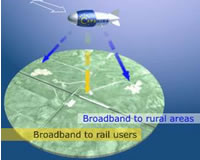 Broadband is taking off everywhere, speeds are increasing and everybody’s happy. Well almost. Broadband isn’t available to all, especially those in more rural areas.
Broadband is taking off everywhere, speeds are increasing and everybody’s happy. Well almost. Broadband isn’t available to all, especially those in more rural areas. Other approaches to HAP involve lightweight aircraft, such as the European-funded Capanina project.
Other approaches to HAP involve lightweight aircraft, such as the European-funded Capanina project. T-Mobile is offering a free WiFi pilot service on Southern Rail’s busy London-to-Brighton train service in readiness for a full launch in June.
T-Mobile is offering a free WiFi pilot service on Southern Rail’s busy London-to-Brighton train service in readiness for a full launch in June. T-Mobile manager for WiFi Jay Saw was in full corporate PR spin mode as he enthused: “We are the only operator that has placed GPRS, 3G and WiFi at the centre of its strategy. That differentiates us from the competition. We’re the world’s largest network – by our own definition.”
T-Mobile manager for WiFi Jay Saw was in full corporate PR spin mode as he enthused: “We are the only operator that has placed GPRS, 3G and WiFi at the centre of its strategy. That differentiates us from the competition. We’re the world’s largest network – by our own definition.”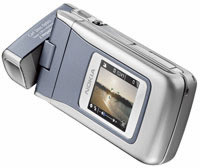 Nokia continues to be the Big Cheese of the worldwide mobile handset market, shipping nearly twice as many phones as its nearest competitor, Motorola.
Nokia continues to be the Big Cheese of the worldwide mobile handset market, shipping nearly twice as many phones as its nearest competitor, Motorola.